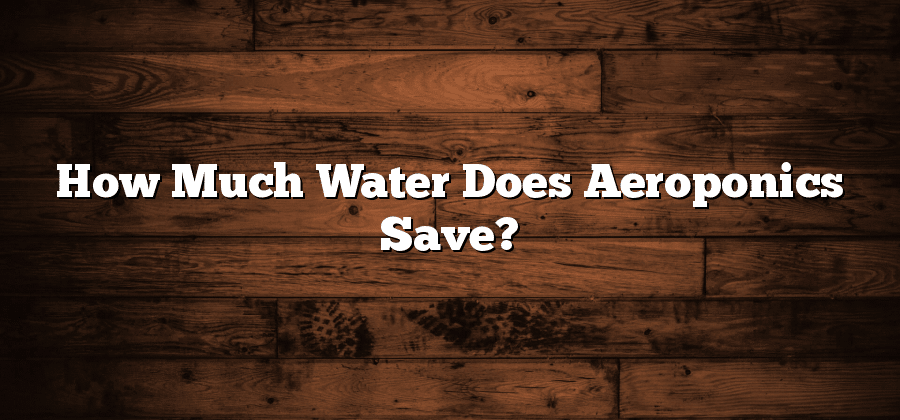Understanding the Water-Saving Potential of Aeroponics
In recent years, the urgency to find innovative ways to conserve water has become increasingly important. One such technique that has gained attention is aeroponics – a method of growing plants without the use of soil. Aeroponics relies on a misting system to deliver nutrients directly to the roots of the plants, resulting in significant water savings compared to traditional irrigation methods.
The water-saving potential of aeroponics lies in its ability to provide plants with the exact amount of water they need, eliminating any excess waste. With traditional soil-based irrigation, water is often overused and can easily evaporate or be absorbed by the soil before the plants can fully benefit from it. In aeroponics, the fine mist efficiently distributes nutrients and water to the roots, ensuring maximum absorption and minimal loss. As a result, the water consumption in aeroponic systems can be drastically reduced, making it an increasingly popular choice for sustainable farming practices.
Exploring the Efficiency of Aeroponic Systems in Water Usage
One of the key advantages of aeroponic systems is their efficiency in water usage. Compared to traditional irrigation methods, such as soil-based systems or even hydroponics, aeroponics stands out for its ability to conserve water. This is primarily due to the fact that aeroponics utilizes a mist-like spray of water and nutrients directly onto the roots of plants, minimizing water loss through evaporation and ensuring that every drop is utilized effectively.
In aeroponic systems, water is sprayed in a highly targeted manner, creating a fine mist that envelops the roots. This targeted approach prevents water from being wasted on unnecessary areas, ensuring the plants receive exactly what they need and nothing more. The roots absorb the water efficiently, leaving little to no water runoff. Additionally, the recirculation system employed in many aeroponic setups allows for further water conservation, as any excess water that is not absorbed by the plants can be collected, filtered, and reused. This closed-loop approach not only helps conserve water but also minimizes the need for additional nutrients, creating a more sustainable and cost-effective system.
The Science behind Aeroponics and Water Conservation
Aeroponics, a cutting-edge agricultural technique, has gained attention for its potential to conserve water. At the heart of this innovative system lies the science behind aeroponics and its ability to optimize water usage. Unlike traditional irrigation methods, which require large volumes of water to be applied continuously, aeroponics takes a more efficient approach by delivering moisture directly to the plant roots in the form of a fine mist.
This method utilizes a combination of air, water, and nutrients to create an environment where plants can thrive without excessive water consumption. By suspending the plant roots in a nutrient-rich mist, aeroponics maximizes water utilization by providing moisture only when and where needed. The root system is exposed to the optimum balance of air and water, enabling plants to absorb essential nutrients and water efficiently. This precise delivery system allows aeroponic systems to use up to 95% less water compared to traditional irrigation methods, making it a promising solution for water conservation in agriculture.
Comparing Aeroponics to Traditional Irrigation Methods in Water Consumption
Aeroponics, a cutting-edge method of growing plants without soil, has gained attention for its potential to revolutionize agriculture. One of the key advantages of aeroponics is its significant water-saving capabilities when compared to traditional irrigation methods. Traditional irrigation methods, such as flood irrigation or sprinkler systems, often result in inefficient water usage due to water runoff and evaporation.
In contrast, aeroponics utilizes a misting system that delivers water directly to the roots of the plants. This targeted approach allows for precise control over water delivery, ensuring that the plants receive the necessary amount of moisture without any wastage. As a result, aeroponic systems can potentially reduce water consumption by up to 95% compared to conventional irrigation methods. This not only conserves water resources but also offers economic benefits by reducing water costs for farmers.
Factors Influencing Water Savings in Aeroponic Systems
Factors Influencing Water Savings in Aeroponic Systems
Water conservation is a critical aspect of aeroponic systems, and several factors contribute to the efficient use of water in this innovative agricultural technique. One vital element is the precise control over the amount of water delivered to the roots of the plants. Unlike traditional irrigation methods where water is often wasted due to inefficient distribution, aeroponics allows for targeted application of water. This precision is achieved through the use of misters or foggers that deliver a fine mist of nutrient-rich water directly to the plant roots, minimizing wastage and maximizing absorption.
Additionally, the closed-loop system of aeroponics contributes to significant water savings. In traditional irrigation methods, water often seeps into the ground without being utilized fully by the plants. However, in aeroponics, excess water that is not absorbed by the roots is collected and recirculated back into the system. This recycling process results in minimal water loss and ensures that every drop of water used in the system is efficiently utilized. By implementing these strategies, aeroponics offers a sustainable solution for water conservation in agriculture, making it an environmentally friendly option for food production.






